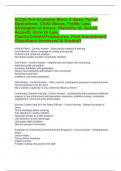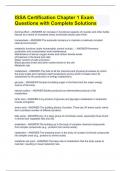SCCJA Pre-Academy Block 2-Basic Patrol
Operations, Child Abuse, Traffic Law,
Strategies of Arrest, Mentally Ill, Sexual
Assault, Intro to Law,
Courts/Crimes/Procedures, First Amendment
(Questions Answered & Graded)
Vehicle Patrol - Correct Answer Most popular method of policing
Cost effective, allows coverage of a large area quickly
Protects from inclement weather
Decreases quality of police-community relations
Foot Patrol - Correct Answer Original and most basic form of policing
Improves public perception
Increases familiarity with geography
Allows more familiarity with people in the community
Restricted movement
Inability to use some equipment
Plainclothes - Correct Answer Often used for investigative purposes or special events
Not all equipment can be used
Must submit to authority of any uniformed officers present
Community Oriented Policing - Correct Answer A philosophy that combines traditional
aspects of law enforcement with prevention measures, problem-solving, community
engagement, and community partnerships
Survival Tactics Vital for Foot Patrol Officers - Correct Answer Always be aware of
cover
Check buildings before entering
Pay attention to nearby vehicles
Approach people at a safe distance
Use darkness to your advantage
Use proper light discipline
Wait for backup if necessary
Examples of Community Oriented Policing Programs - Correct Answer Neighborhood
Watch
Citizen Patrol
Citizen Police Academy
Citizen surveys
Problem solving step process for staff
,Community partnerships
Foot patrols
Ride-alongs
Departmental events
Citizen volunteer programs
Partnerships with public and private sector organizations, including non-profits
Before Leaving Home - Correct Answer Appearance
Attitude
Weapon
Holster
Ammunition Carriers
Flashlight
Scholar - Correct Answer Always be training on new techniques and tactics-never stop
learning
Statesman - Correct Answer Interpersonal communication skills and leadership-ability
to keep your head when everyone else is losing theirs
Warrior - Correct Answer Confidence and competence to run towards danger, not
because it is easy, but because no one else will
Prior to Going In-Service - Correct Answer Patrol vehicle inspection and search
Getting information about previous shift from the officers you're relieving, supervisors,
incident reports, investigators, and FI cards
Preventative Patrol - Correct Answer The noticeable presence of police officers and
patrol vehicles with the intent of deterring crime
Emergency Calls for Service - Correct Answer Responding to emergency situations
such as fires, shootings, hostage incidents, explosions, and suicides
Service Calls - Correct Answer Responding to routine calls for service, citizens who
need assistance
Public Courtesy Calls - Correct Answer Escorts-funerals, bank deposits, hospital
escorts
Locked vehicles
Death notifications
Vacation checks/patrol requests
Proper radio etiquette - Correct Answer Hold microphone 2-3 inches from the mouth at
a 45 degree angle
Talk in a normal tone of voice, not too fast or too slow
Be actively listening
,Think about what you say before you say it
ABC's of radio communication - Correct Answer Accuracy-information is accurate and
factual
Brevity-transmissions are brief and too the point
Clarity-all messages are clear, phonetic alphabet used when needed
Common radio errors - Correct Answer Failure to tell dispatch your location
Failure to give your location in the proper way
Over modulating when calling for help
CYMBALS - Correct Answer Used for vehicle descriptions
C-color
Y-year
M-make
B-body, model
A-any other information such as damage, bumper stickers, customizations
L-license plate and state
S-serial numbers, VIN
What the include in description of a person - Correct Answer Name and any aliases
Race
Sex
Age or narrow range
Height
Weight
Build
Hair
Eyes
Clothing
Scars, marks, tattoos
Articles carried
Lost/Missing Person - Correct Answer A known individual in an unknown location
whose safety may be threatened by conditions related to the environment, weather,
age, or health
Categories of Missing Persons - Correct Answer Children (1-3, 4-6, 7-12)
Youth (13-15)
Hunters
Hikers
Fishermen
Despondents
Walk-aways/constant care individuals
Juvenile Runaways
, General Information Relevant to Predicting Lost Person Behavior - Correct Answer
Circumstances
Environment
Behavior
Personality
Physical conditions
Mental conditions
Initial Reactions of Lost Persons - Correct Answer Trail Running
Traveling a Straight Line
Direction Sampling
View Enhancement
Employing Folk Wisdom
Staying/remaining in one location
Notable Behaviors of Lost Persons - Correct Answer Failure to make a shelter or fire
Discarding equipment
Disrobing
Failure to respond to searchers
Failure to use travel aids
Unlawful Carry of a Handgun - Correct Answer It is unlawful for anyone to carry a
handgun, concealed or not
Exceptions to Unlawful Carry - Correct Answer Law enforcement
Military
Gun show attendees
Licensed hunters
Firearms sellers
Security guards
Individuals in a parade
A person in his house or on his property
A CWP holder
A driver with the firearm secured in a closed glove compartment, closed console, closed
trunk, or closed container
A person who just purchased a firearm
A prison guard
A person given a permit by SLED
A business owner
A patron of a gun shop or range
A person transferring a gun from their vehicle to a specified location
A motorcycle rider with the firearm secured in a closed saddlebag or closed container
Unlawful Sale or Delivery of a Handgun - Correct Answer It is unlawful for a person to
knowingly sell, offer to sell, deliver, lease, rent, barter, exchange, or transport for sale a
firearm to a person who is not supposed to have one






